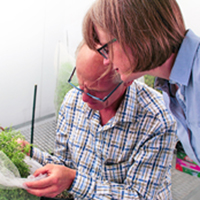
Research unleashes power of pulse crops
2016 has been designated as International Year of Pulses by the United Nations, to heighten awareness about the crops’ benefits in terms of nutrition, sustainable food production and food security. Saskatchewan is a lead player.
By Michael RobinThe centre of it all
Farmer-driven research and development has been the hallmark of pulse crop production in the province since the first varieties were developed at the University of Saskatchewan’s Crop Development Centre (CDC) 40 years ago.
“In terms of research excellence, the pulse crop research and breeding group is now one of the most successful programs in the world,” said CDC Managing Director Kofi Agblor. “The U of S is a major partner in both chickpea and pea genome sequencing initiatives and is the lead for the lentil genome sequencing initiative.”
Since the 1970s, the CDC has developed dozens of varieties of pea, lentil, chickpea, dry bean and faba bean. Advanced genomics-based tools such as marker-assisted breeding will hasten development even more.
A producer levy, administered through the Saskatchewan Pulse Growers (SPG), provides strong support for crop research and a critical link to farmer priorities.
“Disease resistance and weed control certainly are very important for the growers,” said U of S plant sciences professor Bert Vandenberg. “We also focus on seed quality—size, color, shape—because pulses are primarily an export crop and our international customers have very specific preferences. Processing quality is also a priority.”
Current research is also looking at improved nitrogen-fixing capabilities to enhance soil fertility, nutritional value of the end crop and enhanced yield. Here, genetic diversity is crucial.
Vandenberg and fellow CDC researcher Kirstin Bett are developing genomic tools to identify and incorporate genetic diversity for lentils. Their work is backed by Genome Canada, Western Grains Research Foundation, SPG, Saskatchewan’s Agriculture Development Fund (ADF) and organizations such as the Global Crop Diversity Trust.
Near and far
Genetics may also help farmers grow chickpeas more easily for an expanding and lucrative North American market. CDC researcher Bunyamin Tar’an is part of an effort to incorporate genetics from wild relatives of chickpea. The project, funded through the U.S. Agency for International Development, is led through the University of California-Davis.
Tar’an is chasing traits such as stress tolerance, yields and nitrogen-fixing capacity with the aim of producing varieties that can grow further north, into Saskatchewan’s dark brown soil zone. The work is supported by SPG, ADF and WGRF.
SPG numbers show the province’s farmers produce more than three-quarters of Canada’s field peas, 96 per cent of its lentils, and 99 per cent of its chickpeas.
While the province’s pulse crops find their way onto dinner plates around the world via export, Saskatchewan expertise is also helping families halfway around the world feed themselves, earn income and preserve soils.
Researchers from the Colleges of Agriculture and Bioresources, Pharmacy and Nutrition and the Department of Sociology are working with colleagues at Hawassa University in Southern Ethiopia to harness pulses to improve nutrition in poor rural regions.
Ethiopia has one of the highest rates of malnutrition in the world, explained Carol Henry, associate professor in the College of Pharmacy and Nutrition. This is in part due to heavy reliance on crops such as wheat, teff (a local grain) and root crops such as cassava.
“These crops are high in carbohydrates and have little or no protein,” Henry said. “They also deplete nitrogen from the soil, making it less fertile for subsequent crops.”
Backed by funding from Canada’s International Development Research Centre (IDRC), the Canadian-Ethiopian team, has worked over 17 years to produce superior varieties of peas, lentils and beans. They also identified local rhizobia—nitrogen-fixing bacteria that live on pulse crop roots.
“These bacteria, when spread onto the seeds of improved pulse varieties, increase crop yields up to 60 per cent and leave valuable nutrients in the soil for the next season's crop,” said Bruce Coulman, a U of S plant breeder involved with the project. “The nitrogen fixation also provides an accessible, effective, and affordable alternative to inorganic nitrogen fertilizers, which few smallholder farmers can afford.”
Outreach is critical to the success of the project. This demands expertise from nutrition and gender researchers, to soil and plant scientists, food processers, and post-harvest marketers.
For example, the research team had to demonstrate to farmers that pulses were a worthwhile option. Outreach extended to the kitchen, where women were introduced to techniques such as sprouting pulses to make nutrients more available and mixing pulses with grains to provide more complete nutrition.
“It’s allowed for increased consumption at the household level and extra income through the sale of pulses at market,” said U of S nutrition scientist Gordon Zello. “It has also led to improved nutrition status in the highest risk populations, that is, adolescents, women and children.”
The project is on target to reach about 70,000 farmers over the next two years.
There is no doubt that U of S scientists have their fingers on the pulse of this area of research.

